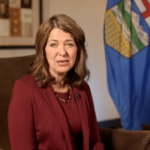Gender Ideology
Hundreds of teen girls in Canada have undergone double mastectomies due to gender ideology
With the ongoing debate surrounding parental rights and the public school practice of “socially transitioning” children without telling parents unfolding in every major media outlet in Canada – especially after Saskatchewan Premier Scott Moe invoked the “notwithstanding clause” to prevent activist judges from derailing parental rights legislation – a key aspect of gender ideology is being largely ignored. “Social transitioning” is the practice of changing a child’s name and pronouns, usually to facilitate a social “sex change” – referring to a boy as a girl, or a girl as a boy. According to a recent report commissioned by the U.K.’s National Health Service, it has significant psychological implications, which is why authors of the report recommended against the practice.
Most significantly, “social transitioning” is usually the first concrete step towards physical “transitioning,” a process that often begins with puberty blockers followed by cross-sex hormones, and then, if the child continues to identify as the opposite sex, “top surgery” and “bottom surgery.” Top surgery is the euphemism used to describe a double mastectomy, the surgical removal of healthy breasts. Bottom surgery refers to castration and the creation of a “neovagina” for males; the removal of flesh from the forearm to create a faux-penis for females. Details of these surgeries, which Scott Newgent, a woman who attempted a “sex change,” described on my LSN podcast, are genuinely gut-wrenching.
That is why we do not talk about “double mastectomies” or “castrations” – we don’t even use the term “sex change surgeries,” a phrase that has been swapped for “gender affirming care,” which sounds far less dangerous and experimental and has the premises of the transgender movement built in to boot. But the reality is that we cannot have a genuine debate about “social transitioning” in Canadian schools without discussing, in clear language, the trajectory that this puts children on to begin with. The legal experts and journalists and politicians angrily denouncing parental rights and advocating for the rights of “trans kids” are remarkably vague when it comes to the details of what “transitioning” these kids actually looks like.
The National Post, Canada’s only center-right-leaning newspaper, is beginning to cover this aspect of the debate in clearer language. On September 29, they published a report titled “Hundreds of trans teens under 18 have had breasts removed in Canada, new data show.” Leaving aside their acceptance of the premises of the transgender movement – if you accept that these teens are, in fact, “trans,” you to some degree accept the surgeries that follow from that premise – this report was revealing, noting that “hundreds of adolescents in Canada have undergone female-to-male ‘top surgery’—double mastectomies—over the past five years.” From the Post report:
Hospitalizations and day surgery visits for bilateral mastectomies for gender reassignment surgery have risen sharply, from 536 in 2018-19, to 985 in fiscal 2022-23, according to data compiled for National Post by the Canadian Institute for Health Information. Of the 4,071 visits in total involving gender-affirming mastectomies or breast reductions reported since 2018, 602 involved youth 18 and under. Of those, 303 involved teens 17 and younger. The youngest age was 14.
The numbers tell only part of the story. The CIHI data exclude Quebec hospitals as well as surgeries performed in private clinics like the McLean Clinic in Mississauga, which describes its surgeons as “industry pioneers” for top surgery — mastectomies and breast reductions in those assigned female at birth, and breast augmentation for those born male transitioning to female. One specialist in transgender health issues said that, when applying for OHIP funding for people seeking top surgery, “50 to 70 per cent will go to McLean.”
The Post does carefully lay out the rationalization behind “top surgery,” presumably to signal neutrality – but again, their language indicates an acceptance of the transgender movement’s premises: “Female-to-male chest surgery involves removing the breasts to achieve a flatter, more masculinized torso, to better align the person’s physical body with their gender identity and reduce gender dysphoria, defined as the persistent distress that can accompany the incongruence between the gender one identifies with and one’s gender at birth.” To their credit, the Post does highlight the fact that many are concerned about the potential for lifelong health effects, the possibility of regret, and ties the permanence of these surgeries to the parental rights protests erupting across Canada.
The report also notes that the majority of minors seeking “sex change” surgeries are female:
One study involving 174 trans and non-binary children and teens referred to 10 gender identity clinics in Canada found 34 per cent of those assigned female at birth were referred for top surgery. Most were 15 or 16 at the time of referral…According to CIHI, of the 536 hospital visits for transgender reassignment mastectomies in 2018-19, 76, or 14 per cent, involved 18-year-olds and younger.
That age group accounted for 18 per cent of visits for mastectomies (174 out of 991) reported in fiscal 2021-22, and 14 per cent of visits (135 out of 985) in 2022-23. The percentage dipped last year as hospitals grappled with pandemic-driven surgical backlogs. “But the private clinics just kept churning them through,” said one doctor familiar with trans medicine who requested anonymity fearing professional repercussions.
“The fact that you can’t get the numbers from private clinics…. It’s very cloak-and-dagger,” the doctor said. “They’re still billing OHIP. That’s tax dollars. That should be publicly accessible information. We need to see these numbers and ask questions,” the doctor said. “If this was just about the schools, and just about kids being allowed to wear what they want and say what they want and be called whatever name they want and it stopped there, who would care? But medicine got involved.”
What do these “top surgeries” consist of? Here, the Post is admirably frank:
For a double mastectomy, typically two incisions are made on the bottom border of the pectoral muscle or chest area, according to the McLean Clinic’s website. “The skin is then lifted to surgically remove the breast tissue underneath.” The nipples are removed, re-sized and repositioned by grafting “to suit the new masculine appearance of the chest.” It’s a day-surgery procedure performed under general anesthesia that takes approximately two hours. Complications can include bruising, wound infections and scarring. People lose nipple sensation as well as the ability to breastfeed should they become pregnant.
That last fact is something that haunts many “de-transitioners” – girls who had their healthy breasts removed while suffering from gender dysphoria as young teens, and later realized that permanent, life-altering, and body-altering surgeries were not the answer to their struggles. The realization that they will never be able to breastfeed their own children – indeed, if they haven’t been rendered permanently infertile by puberty blockers, cross-sex hormones, or “bottom surgery,” as most are – is truly heartbreaking. That fact, I notice, is absent from the Post’s reporting – and there are many “de-transitioners” who are eager to speak about their heartbreaking experiences should journalists express interest. I wonder how many of the Canadian girls who had their breasts cut off will one day express the same regret.








